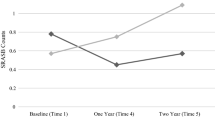Abstract
Although school attendance has been mandatory in California for nearly a century, school attendance rates have approached 90% only over the last few decades. Truancy has been a problem since the onset of mandatory education, and nonattendance has always been seen as harmful not only to individuals, but also to the greater society. Recently the Office of Juvenile Justice and Delinquency Prevention (U.S. Department of Justice), the California Board of Corrections, and the California Legislature have been focusing their attention on truancy as a risk factor, if not as a stepping stone, to criminal activity. Recently, California legislators created a new article in the California Education Code known as the Targeted Truancy and Public Safety Grant Program (TTPS). This paper evaluates truancy abatement efforts in two school districts: one funded through TTPS and the other through the California Board of Corrections
Similar content being viewed by others
References
Bracey, G. W. (1995). Final exam: A study of the perpetual scrutiny of American education. Bloomington: Technos Press.
California Legislature. (1979). Attendance and absenteeism in California schools. Joint Legislative Audit Committee Report to the California Legislature prepared by the Auditor General. Report P-832.
Ferguson, D. M., Lynskey, M. T., & Horwood, L. J. (1995). Truancy in adolescence. New Zealand Journal of Educational Studies, 30(1), 25–37.
Fiordaliso, R., Lordeman, A., Filipczak, J., & Friedman, R. M. (1977). Effects of feedback on absenteeism in the junior high school. Journal of Educational Research, 70(4), 188–192.
Garry, E. M. (1996). Truancy: First step to a lifetime of problems. Washington, DC: U. S. Department of Justice.
Helm, C. M., & Burkett, C. W. (1993). Computerized absence reporting. In J. J. Cohen & M. C. Fish (Eds.), Handbook of School-based Interventions (pp. 34–35). San Francisco: Jossey-Bass.
Levine, R. S. (1984). An assessment tool for early intervention in cases of truancy. Social Work in Education, 6(3), 133–150.
Levine, R. S., Metzendorf, D., & VanBorskirk, K. A. (1986). Runaway and throw away youth: A case for early intervention with truants. Social Work in Education, 8, 93106.
Office of Education, U.S. Department of Health, Education and Welfare. (1976). Interviews of4202 California Households. Survey of Income and Education. Washington, D.C.
Savoye, C. (1983, October 3). The ‘attendance robot’— a truant officer’s best friend. Christian Science Monitor, p. 7.
Schultz, R. M. (1987). Truancy: Issues and interventions. Behavioral Disorders, 1, 117–130.
Shuster, B. (1995, June 28). L. A. school truancy exacts a growing social price. Los Angeles Times, pp. A1, A12.
Sommer, B. (1985a). Truancy and early adolescence. Journal of Early Adolescence, 5, 145–160.
Sommer, B. (1985b). What’s different about truants? A comparison study of eighth-graders. Journal of Early Adolescence, 14, 411–423.
Stewart, M. J., & Ray, R. E. (1984). Truants and the court: A diversionary program. Social Work in Education, 6(3), 179–192.
Tuck, K. D., & Shimburi, F. N. (1988). An evaluation of a truancy prevention plan. Washington, DC: District of Columbia Public Schools, Division of Quality Assurance. (ERIC Document Reproduction Service No. ED 257 210).
Unger, H. G. (1996). California. Encyclopedia of American education. New York: Facts on File.
U.S. Census Bureau of Census. (1985). Statistical abstract of the United States, 1986 (196th ed.). Washington, DC: U.S. Government Printing Office.
Wallin, J. W. (1938) The nature and implications of truancy from the standpoint of the schools. Journal of Exceptional Children, 5, 1–6.
Zwick, R., Neuhoff, V., Marascuilo, L. A., & Levin, J. R. (1982). Statistical tests for correlated proportions: Some extensions. Psychological Bulletin, 92, 258–271.
Author information
Authors and Affiliations
Corresponding author
Rights and permissions
About this article
Cite this article
Pobanz, M.S., Furlong, M.J., Casas, J.M. et al. California’s Targeted Truancy and Public Safety Program: Preliminary Outcomes Associated with Two School Districts’ Truancy Abatement Efforts. Contemp School Psychol 4, 66–79 (1999). https://doi.org/10.1007/BF03340870
Published:
Issue Date:
DOI: https://doi.org/10.1007/BF03340870



